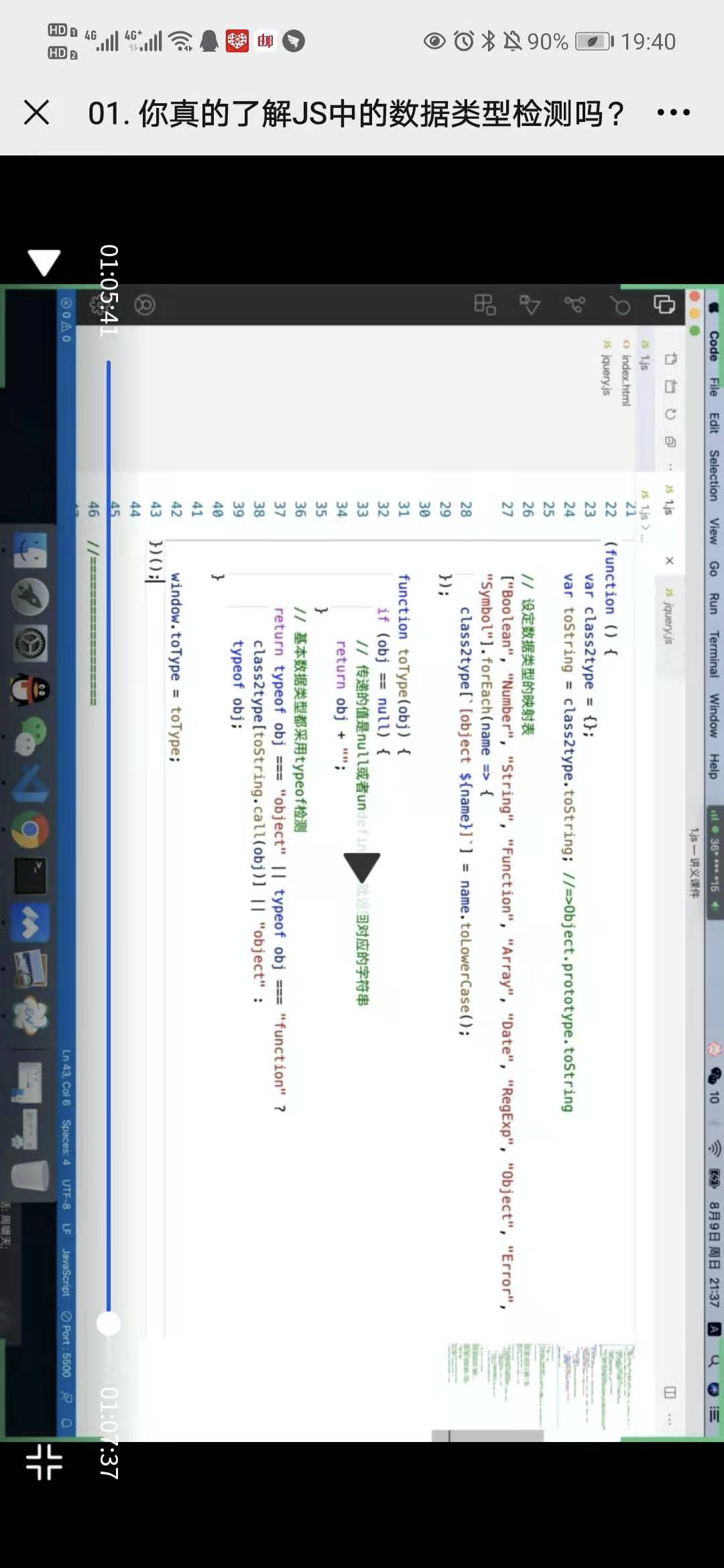一.typeof
typeof操作符返回一个用来表示数据类型的字符串,注意typeof运算之后的结果都是字符串类型的
注意:typeof是一个操作符,不是一个函数!
1.“string” 值是字符串
2.“boolean” 值是布尔值
3.“number” 值是数值
4.“undefined” 值未定义
5.“object” 值是对象,数组或null
6.“function” 值是函数
7.“symbol” 值是Symbol
var num=123;
var str="123";
var boo=true;
var und=undefined;
var arr=[];
var obj={};
var nul=null;
var fun=function(){};
var s = Symbol();
console.log(typeof num); //"number"
console.log(typeof str); //"string"
console.log(typeof boo); //"boolean"
console.log(typeof und); //"undefined"
console.log(typeof arr); //"object"
console.log(typeof obj); //"object"
console.log(typeof nul); //"object"
console.log(typeof fun); //"function"
1 优点
只能检测出number,boolean,string,symbol,undefined,function,object
2.缺点
基本数据类型,null返回object 其他都可以返回正确结果
引用数据类型,除了function以外,都返回object
function返回function类型
二.instanceof
instanceof运算符用于测试构造函数的prototype属性是否出现在对象的原型链中的任何位置.
语法: object instanceof 构造函数
返回值:如果是这个构造函数构造出来的,返回true,否则返回false。
console.log(1 instanceof Number); //false
console.log("liuqiao" instanceof String); //false
console.log(true instanceof Number); //false
console.log(function(){} instanceof Function); //true
console.log({} instanceof Object);//true
console.log([1,2,3] instanceof Array);//true
得出一个结论:instanceof 运算符用于对象类型检测,无法检测基本数据类型,因为内部机制是通过判断对象的原型链中是不是能找到类型的 prototype。
并且也无法检测undefined和null ,因为他们两个比较特殊,使用instanceof检测时,浏览器根本不识别,会报错
class Animal {
constructor() {
}
}
class CatParent extends Animal {
constructor() {
super();
}
}
class CatSon extends CatParent {
constructor() {
super();
}
}
var catson = new CatSon();
console.log(catson instanceof CatSon);//true
console.log(catson instanceof CatParent);//true
console.log(catson instanceof Animal);//true
console.log(catson instanceof Object);//true
instanceof 只要该实例的父亲辈,爷爷辈以及祖先辈,都会返回true
1.优点
可以检测出某特定的引用类型具体是某种类型
2.缺点只能检测引用类型
三.constructor
每个对象都有一个隐藏属性constructor,该属性指向对象的构造函数(类)
console.log(("1").constructor === String);//true
console.log((1).constructor === Number);//true
console.log((true).constructor === Boolean);//true
console.log(([]).constructor === Array);//true
console.log((function () { }).constructor === Function);//true
console.log(({}).constructor === Object);//true
1.优点
基本上基本数据类型和引用数据类型都可以检测,但是除了自定义的对象外
2.缺点
为什么说除了自定义对象外都可以检测 ,因为检测自定义对象时不可靠!具体原因参考参考用constructor来做类型识别,并不可靠
函数的 constructor 是不稳定的,这个主要体现在自定义对象上,当开发者重写 prototype 后,原有的 constructor 引用会丢失,constructor 会默认为 Object
undefined和null无法检测
四.Object.prototype.toString.call()
使用Object.prototype上的原生toString()方法判断数据类型
当要判断多类型比较复杂的时候,强烈推荐使用这个方法
jQuery就是通过这种方式来判断的!
var m = Object.prototype.toString;
console.log(m.call("aaa"));//[object String]
console.log(m.call(1));//[object Number]
console.log(m.call(true));//[object Boolean]
console.log(m.call(null));//[object Null]
console.log(m.call(undefined));//[object Undefined]
console.log(m.call([]));//[object Array]
console.log(m.call(function () { }));//[object Function]
console.log(m.call({}));//[object Object]
console.log(m.call(new Date));//[object Date]
console.log(m.call(/d/));//[object RegExp]
function Person() { };
console.log(m.call(new Person));//[object Object]
1.优点
基本上的数据类型都可以检测
2.缺点
自定义的类是不能准确判断的,这里可以采用instanceof
Object.prototype.toString()本身是允许被修改的,而我们目前所讨论的关于Object.prototype.toString()这个方法的应用都是假设toString()方法未被修改为前提的。
3,扩展
我们发现上面打印[object String]类似这种不太完美,比如我想直接打印string呢
function parse(str) {
return str.slice(8, -1).toLowerCase();
}
封装一个函数,实际上Object.prototype.toString.call()得到的是一个字符串,只要我们对他进行截取即可,然后转为小写,就可以得到我们想要的结果,与typeof打印的格式一样